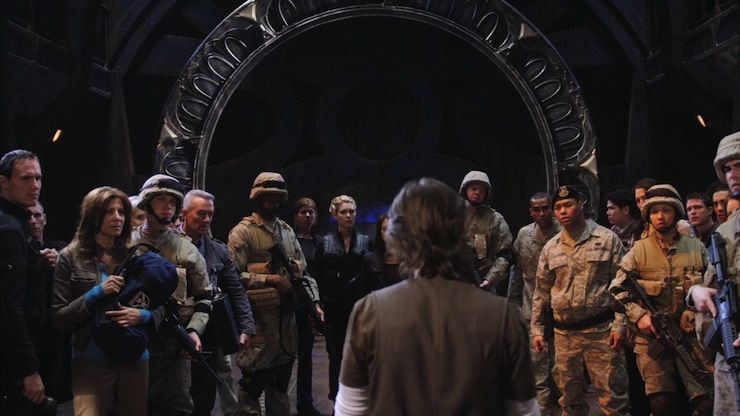Stargate Universe Season 1
Executive producers: Robert C. Cooper, Brad Wright
Original air dates: October 2, 2009 – June 11, 2010
Mission briefing. The Atlantis database includes a nine-chevron address (well, eight chevrons, plus whatever the point of origin is). It’s believed that there should be a way to dial an even greater distance than between galaxies with nine chevrons. Dr. Nicholas Rush is recruited (by Jackson) to work on it, and he spends two years trying to solve the problem—in that time, his wife dies of a never-specified illness.
The Air Force embeds the problem in a videogame on the off-chance that someone will solve it. That someone turns out to be a young slacker named Eli Wallace, who is beamed to the General George Hammond and brought to Icarus base. Icarus is a top-secret SGC installation that is on a planet full of naquadria, so it has enough energy to power a nine-chevron wormhole.
Eli is brought to Icarus just as the base is attacked by the Lucian Alliance. Carter on the Hammond fights them off, as do 302s led by Colonel David Telford, but the base is compromised. The Stargate is hooked up geothermally so it can’t dial short distances without overloading (that’s why they were taken on the Hammond instead of gating), so they’re trapped. Eli has a breakthrough, Rush dials the gate using the Atlantis address, and they go through to an ancient Ancient ship called Destiny just before the Alliance destroys the base—and the planet.
Destiny is several galaxies away from Earth. The ship has been flying on a prearranged course for millions of years, and it’s not in the best shape. Its crew is long gone, and it has equipment (including a Stargate) that is millions of years behind the Ancient technology they’re all familiar with (but still quite far ahead of mainstream Earth tech). They have no control over the ship, but it does come out of hyperdrive periodically for assorted reasons; each time there’s a countdown clock indicating how long before they’ll go back into faster-than-light speeds, so the crew can periodically gate to planets (which were seeded with Stargates by ships that came ahead of Destiny) for supplies and such.
Rush, along with Adam Brody, Dr. Dale Volker, and Dr. Lisa Park, are charged with learning more about the ship. Colonel Everett Young remains in command, though he butts heads regularly with the sullen Rush, with the IOA representative Camille Wray, who is in charge of HR, but is also the IOA’s only person on the ship, and with Telford back on Earth, who uses the communciation stones that Rush brought along to occasionally show up on board and cause trouble. Also along for the ride are Senator Alan Armstrong and his daughter (and chief of staff) Chloe. Armstrong is badly hurt during the attack, and sacrifices his life to save the ship from what would be a fatal leak of air through a damaged shuttle. Chloe winds up in a relationship with Young’s second in command, Lieutenant Matthew Scott. Scott also previously knocked boots with the third in command, Lieutenant Vanessa James, which causes some discomfort for the latter (the former, for what it’s worth, doesn’t seem to give a damn); Scott also has a kid out of wedlock back on Earth. In charge of the troops is Master Sergeant Ronald Greer, who was in the brig for striking Telford when the Alliance attacked. The closest they have to a doctor is a medic, Lieutenant Tamara Johansen, who was about to transfer out after a disastrous affair with Young. She later finds out she’s pregnant from that affair.
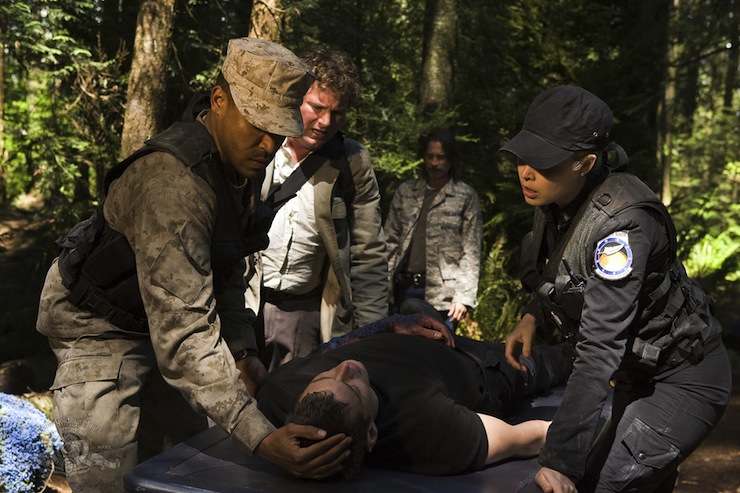
They soon learn that Destiny collects energy from suns, so they don’t have to worry about power long-term. They obtain water from an ice planet, though it turns out to be infected and nearly kills the entire crew—they only survive due to time travel shenanigans. They find a paradise of a planet that isn’t in Destiny‘s database, and some folks stay behind, assuming that whatever aliens created the planet will take care of them. A bunch of tiny ticks come on board that give the crew hallucinations.
When Sergeant Spence kills himself, unable to stand living on Destiny, Rush makes it look like it wasn’t a suicide, so Young will be suspected. In retaliation, Young strands Rush on a planet to die, though he is instead kidnapped by aliens who later attack Destiny and kidnap Chloe. They manage to rescue Rush and Chloe, but the damage is done, and Rush, Wray, Chloe, and most of the other civilians (the notable exception is Eli) decide to wrest power from the military. This is a rather spectacular failure, especially when it’s revealed that Rush has a tracking device from the aliens in his body. It’s surgically extracted.
At one point, Scott, Greer, Chloe, and Eli are stuck on a planet when Destiny goes to FTL, but jumping back through various gates enables them to make contact and eventually get on board just as it’s about to go between galaxies.
Both Scott and Rush receive odd visions of Telford’s life after having exchanged bodies with him using the communication stones. That shouldn’t happen, but it turns out to be a byproduct of his being brainwashed by the Lucian Alliance using Goa’uld technology. Telford is the (unwilling) mole who gave away Icarus’s position. Rush exchanges places with Telford using the stones, and while the former tries to infiltrate the Lucian Alliance, the latter is taken prisoner by Young. With O’Neill’s blessing, Young breaks Telford of the brainwashing (which almost kills him) while Rush is captured by Kiva of the Alliance and forced to finish the work of their own version of Icarus on another naquadria-laced planet.
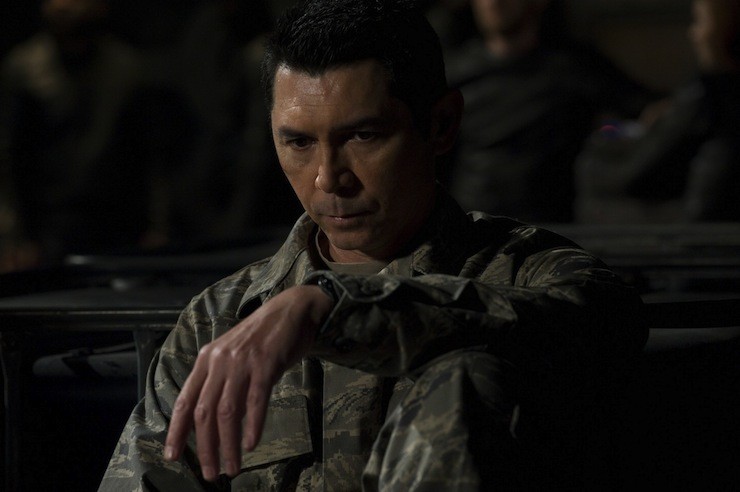
The Lucian Alliance succeeds in invading Destiny, leading to a tense standoff—made even more tense by Destiny being in a system with a pulsar that is straining the ship’s shields to their limit…
Best episode: “Time.” A superbly structured episode, done in the “found footage” style involving the Kino, it’s a cleverly done time travel adventure that makes use of what was established in “1969” on SG-1. The Stargate franchise has done so many time travel episodes that you want to just roll your eyes at the thought of another one, but this one works beautifully, especially the “what the hell was that?” reveal when we find out that the crew is watching footage of events that never actually happened to them. Points to Robert C. Cooper, who both wrote and directed.
Honorable mention to “Subversion,” which for a few moments feels like an SG-1 episode, with Jackson tailing Rush, O’Neill being snarky (I especially like his comment on National Security briefings to Young), the two of them arguing about human rights, and so on. Plus, it’s a tense adventure, as we find out who attacked Icarus and why Telford’s such as asshat.
Worst episode: Hard to narrow it down, as so many episodes feel like so many other episodes, and they all have generic one-word titles so I have to struggle to remember which is which, but I think I want to reserve my harshest criticism for “Faith,” in which a crew already well populated with people doing stupid things doubles down on it with the morons who think staying on that planet is in any way, shape, or form a good idea. And the tension is wholly artificial, especially since the prime agitator for staying on the planet is a character we’ve never seen before and don’t care about, and we know that nobody in the opening credits is going to stay behind.
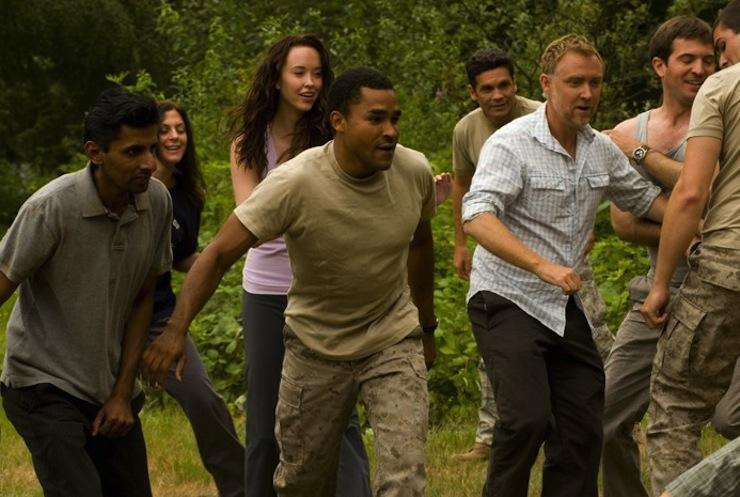
Dishonorable mention to the “Incursion” two-parter, which makes Carter into an incompetent and fails to convince us that the Lucian Alliance is now suddenly a genuine threat after being a pathetic collection of gangsters on SG-1. Of course, it helps that Carter isn’t the only incompetent—Young manages to screw up eight ways from Sunday…
Can’t we just reverse the polarity? Destiny has been on a prearranged course for millions of years, and the ship’s still in working order, thus continuing the Ancients’ tendency to build stuff to last. The ship is powered by solar collectors, thus having an infinite power supply as long as there are stars. It has several primitive versions of other Ancient tech the SGC has encountered, including an early version of the repositories that nearly killed O’Neill twice (in the form of a chair that’s not unlike the control chair seen in Antarctica and Atlantis), and a Master Code based on genetics, an early version of the only-people-with-the-right-genes-can-operate-their-tech thing.
My life’s work was to be here. Rush is as brilliant as Carter or McKay or Zelenka, but personality-wise, he makes McKay look like Zelenka, as he’s manipulative, surly, and non-cooperative. Even when he collaborates with Wray to wrest control from the military, he still has his own agenda he’s pursuing without bothering to share it with his alleged allies. It’s obvious he’d much rather have Destiny to himself without all these other stupid people in his way.
You are here. Eli is a genius who never actually did anything with his life, even getting himself kicked out of MIT. It doesn’t help that his father left him and his nurse mother when the latter developed HIV from a dirty needle. He nonetheless solves an insoluble math problem (the day after Eli cracks it, he’s visited by O’Neill and Rush and beamed to the Hammond).
In our society, the military takes orders from civilian leadership. Wray is the HR director for the Icarus Base, which leads to her being the only IOA official on Destiny. She tries very hard to have an equal voice in what goes on on the ship, and mostly fails, because neither Young nor Rush take her particularly seriously. She is also the first openly gay character in the Stargate franchise, as she is in a long-term relationship with a woman named Sharon Walker, whom she visits via the stones as often as possible.
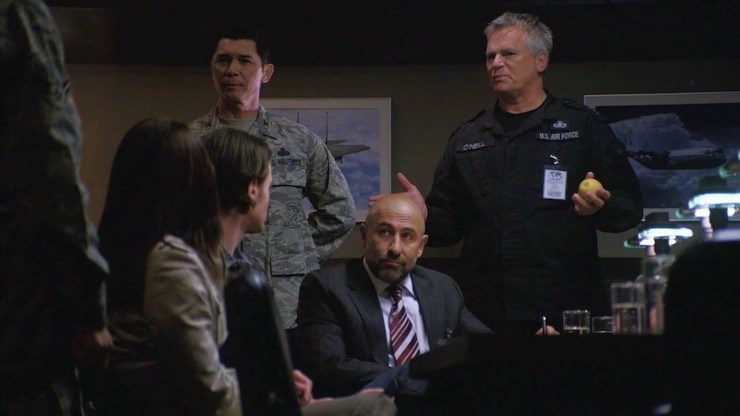
For cryin’ out loud! O’Neill is still in charge of Homeworld Security, and Young reports to him on several occasions. He authorizes Telford’s attempt to bring Destiny home and he supervises the tailing of Rush when he infiltrates the Lucian Alliance.
It might work, sir. Atypically, Carter fails in both her appearances on the show, as both times someone dials Destiny, it blows up a planet and she barely gets out alive—the second time, she loses two 302 pilots.
I speak 23 different languages—pick one. Jackson is the one who recruited Rush to the ninth-chevron project from his teaching position at UC Berkley. He also recorded a primer on the SGC for newbies, which Eli watches in “Air Part 1” and again in “Incursion Part 1.”
You have a go. In “Air Part 1,” we finally see the 304 ship that was named after Hammond, commanded by Carter, first mentioned in Atlantis‘s “Enemy at the Gate.” The ship is also seen in “Incursion Part 1.”
Wayward home for out-of-work genre actors. Universe actually set their sights either outside the genre for most of their guest stars, or among the usual batch of Vancouver regulars. Notable guests not known for their genre work include Christopher McDonald, Lou Diamond Phillips, Reiko Ayelsworth, Kathleen Monroe, Carlo Rota, and Rhona Mitra. (Many of them have at least some genre work—notably, McDonald was in Star Trek: The Next Generation‘s seminal episode “Yesterday’s Enterprise“—but in general the resumés of these folks have a very tiny percentage of genre material prior to 2009.)
Trivial matters. The Stargate used on Destiny and seeded on the planets along its route are of an earlier design than the Milky Way Stargates (which makes them two generations prior to the Pegasus Galaxy ones), where the whole ring rotates instead of a moving inner ring and a standing outer one (or not rotating at all like the Pegasus ones).
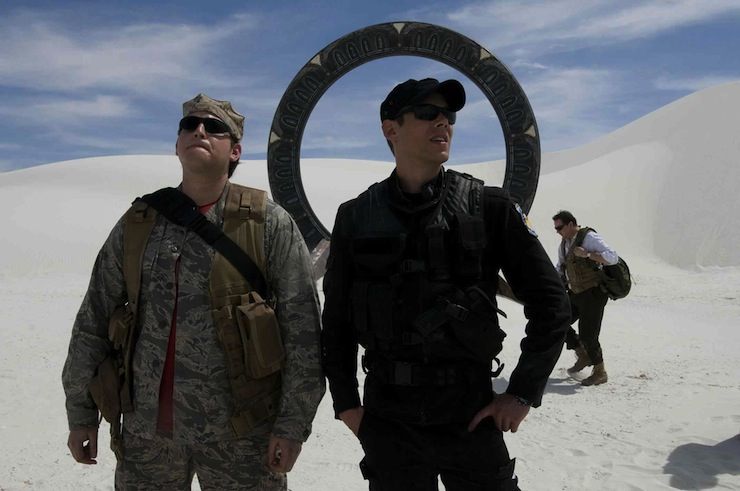
Destiny is able to stay in touch via the stones established in SG-1‘s “Citizen Joe,” and which Jackson and Vala used to contact the Alteran Galaxy and alert the Ori to the Milky Way’s existence in SG-1‘s “Avalon.” The stones enable people to visit Destiny as needed, whether it’s Amanda Perry and her expertise in Ancient technology in “Sabotage” or Brightman coming on board to operate on Rush in “Divided” or O’Neill supervising Everett’s treatment of Telford in “Subversion.” They also enable people to visit their loved ones back home, as seen notably in “Earth.”
This is the first season of a Stargate show to have no scenes set at Stargate Command. All the Earth-bound scenes involving the SGC are at the Pentagon.
This season marks the final onscreen appearances of O’Neill, Carter, Jackson, and Harriman. All four appear in “Air Part 1,” and Harriman and O’Neill are also in Part 2 (in a scene only in the extended version), with O’Neill in Part 3. O’Neill, Jackson, and Carter all are in “Incursion Part 1.” O’Neill and Jackson are both in “Subversion.” O’Neill also appears in “Earth” and Jackson also appears in “Human.” We also see Lee (Bill Dow) in “Air Part 2” and Brightman (Alisen Down, last seen in SG-1‘s “Lockdown“) in “Divided”; both characters will return in season 2.
Naquadria was first established in SG-1‘s “Meridian” as a more powerful, less stable version of naquadah. It isn’t found in nature, and is exceedingly rare. (It’s even rarer after this season when two different planets that have veins of it go boom.)
Telford is brainwashed using the same technology that Apophis used on both Ry’ac and Teal’c in SG-1‘s “Family,” “Exodus,” and “Enemies.” Young breaks Telford of it the same way Bra’tac broke Teal’c in “Threshold,” by killing him and reviving him.
This is the first Stargate series to depict people having sex, and they don’t waste time, either, as we see Scott and James getting it on in a broom closet in “Air Part 1.” Park sleeps her way through the ship and Scott and Chloe wind up pairing off. Young had an affair with Johansen, and he’s trying to reconcile with his wife (a tall order when he can only communicate through the stones). Wray also gets nookie time with Walker.

For the sixth time in Stargate, a female castmember’s pregnancy had to be accounted for. While Amanda Tapping’s and Lexa Doig’s were written around, Alaina Huffman’s was, like Claudia Black’s, Rachel Luttrell’s, and Vaitare Bandera’s, written into the plotline. The original script for “Faith” called for a random background character to be pregnant, but when Huffman revealed her own pregnancy, it was decided to write it in, and establish that Johansen became with child after her tryst with Young.
Chevron seven nine locked. When SyFy picked up Stargate SG-1 in 2002, it immediately became the channel’s biggest hit. Then in 2003, they aired a Battlestar Galactica miniseries, which was followed the next year by a regular series, and Stargate wasn’t the top show anymore, though it was a very close second.
After Atlantis came to an end following its fifth season, the channel wanted a new show in the franchise. It’s unclear what the impetus was for making Universe so much like Galactica—whether or not it was Brad Wright and Robert Cooper who wanted to do Stargate: Galactica or if it was a directive from the network—but whoever’s idea it was to make the show visually dark and filled with shaky-cam visuals and play at being more mature and have characters who are morally ambiguous and stuff, it was a really really stupid idea.
There are elements that work. I have no objection in theory to the darker, shakier visual style, it’s actually in keeping with the desperation of the circumstance.
But overall, it’s carrying a neon sign that says, “LOOK, WE’RE JUST LIKE GALACTICA, SEE? LOVE US!” and it comes across as pathetic.
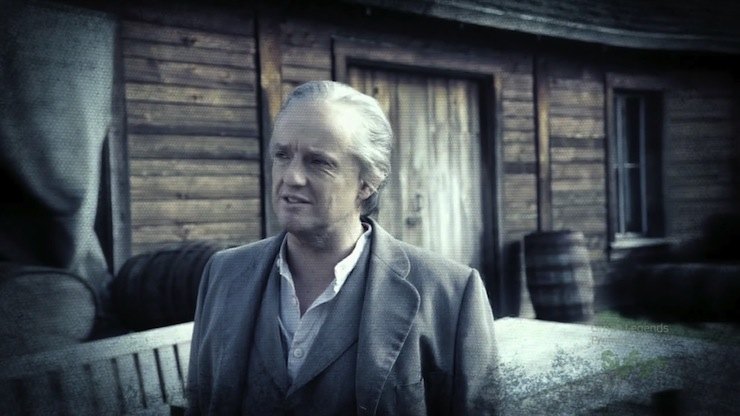
Galactica‘s crew were not the best of the best—they were the failures who were sent to the clapped-out ship being retired because they weren’t talented enough to be on the good ships. That was part of the point, that the last survivors of Caprica were the losers and ne’er-do-wells. Universe‘s crew are also not the best of the best—which makes absolutely no sense because the SGC is a top-secret program that only has the best of the best. If they aren’t the best, they aren’t going to be let into the super-secret club where they get to go to alien worlds and get shot at by megalomaniacs with snakes in their heads and energy vampires who look like Trent Reznor. It makes no sense, none, that someone as spectacularly incompetent as Young would be anywhere near the Stargate program.
Galactica had a civilian woman thrust into a position of power over her head. Ming-Na Wen does the best she can in the role of Wray, but she’s mostly stuck in the middle of the Young-Rush conflict, which doesn’t do the character any favors. (She’s actually more interesting when she goes back to Earth to see Walker—seriously, the gleeful casualness of Wray’s lesbianism is a triumph, particularly in 2009—and verbally fence with Carlo Rota’s magnificently smarmy Strom.) Either way, she’s a pale copy of Laura Roslin.
And Galactica has a scientist with a secret agenda. But Baltar has a secret agenda because his secret is, basically, treason and it involves the Cylons. They try to make Rush out to be more complex than he really is, and it helps that an actor of Robert Carlyle’s incredible talent is there to sell it, but far too often the scripts just make him out to be a dick not because the character as a person calls for it, but because the character’s pigeonhole calls for it. Rush has his moments, mostly due to Carlyle—the bit in “Human” when he laments to Jackson that an uneducated videogame-playing kid figured out in five minutes what he couldn’t figure out in two years is beautifully delivered—but he’s ultimately a type rather than a character.
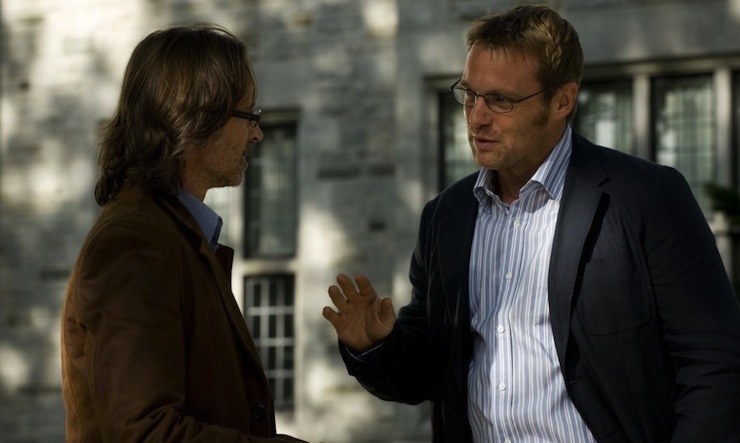
All of the above could possibly be forgiven or at least overcome, but there are two other fatal flaws that sink Universe. The first is an unconscionable cast bloat. You may notice that above there are only three sections for characters from this show, despite there being eight opening-credits regulars and more than half a dozen recurring characters (Wray was bumped from recurring to regular in “Justice”). The problem is, there are too many of them. When I first watched the show six years ago, I simply could not keep track of everyone—not aided by the fact that the characters weren’t interesting enough for me to care. But just from a storytelling perspective, the show doesn’t need Young and Scott as military leaders. It doesn’t need James and Greer as secondary military folk. It doesn’t need Rush and Volker and Eli and Brody and Park as the people who do science. And it doesn’t need Chloe at all, particularly since Elyse Levesque mostly just stands around with her mouth slightly open and whines a lot.
The second problem is even harder to overcome, and the show was never able to: Louis Ferreira is just awful as Young. He has almost negative charisma, and the character’s incompetence as a military leader is matched point for point by the incompetence of the actor playing him. His arguments with Rush have no spark, no bite. To make matters worse, they keep pairing him up with Richard Dean Anderson, who—even in the much more subdued role of head of Homeworld Security—has more charisma in a single smirk in “Subversion” than Ferreira can cobble together over twenty episodes. His line readings are flat, his characterization nonexistent. Even though Carlyle gets top billing, his character is written as a loner, avoiding others where at all possible. The true head of the ensemble is Ferreira, and an ensemble (especially one as big as this) lives or dies on the charisma of its leader. It’s why Babylon 5 was so much better when the bland Michael O’Hare stepped aside for the much more dynamic Bruce Boxleitner, and why Blake’s 7 suffered terribly from the loss of Gareth Thomas.
A third issue doesn’t really come up until the final three episodes of the season, wherein we find out that the bad guys who started this whole thing by attacking Icarus are the Lucian Alliance. SG-1 tried and failed to make these guys a credible threat, and Universe doesn’t do any better. These are galactic thugs who happen to have access to Goa’uld tech, and in the wake of the Goa’uld, the replicators, the Ori, and the Wraith, make the world’s most unconvincing and uninteresting threat. Hell, the only reason they are a threat is because Young is so incredibly bad at his job…
It’s not all bad. Ming-Na, as I said, does quite well in the poorly written part of Wray, Jamil Walker Smith plays a very stereotypical but quite realistic military dude in Greer, and both characters address a particularly appalling lack in the Stargate franchise up to this point, to wit, a lack of non-white, non-heterosexual characters. Haig Sutherland is particularly impressive as Sergeant Hunter Riley, imbuing a lot of character into a tiny role (he also did some of the Kino webisodes that were done as supplements), Julia Benson does likewise with the role of James, and Alaina Huffman continues the Stargate tradition of female medics whom you underestimate at your peril.
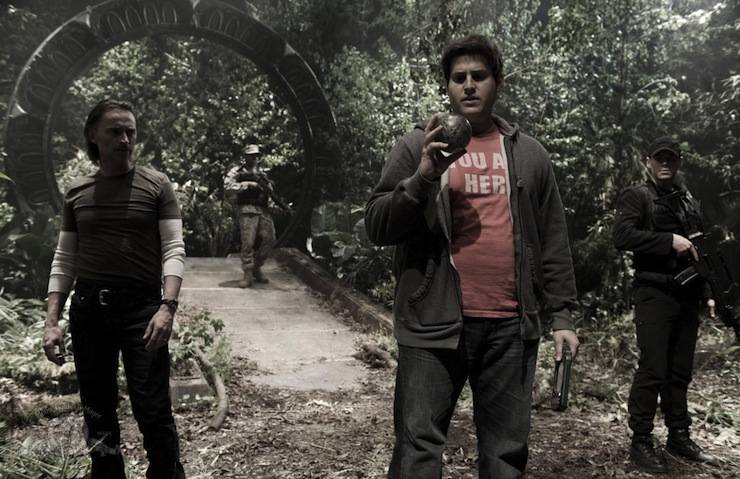
And of course we have David Blue’s Eli, a character who’s not from Galactica but rather from Lost—Eli is, pretty much, Hurley, the overweight everyman who cuts through the crap and is often the conscience of the ship. Blue inhabits the character magnificently, practically the only character on the show who regularly engages in Stargate‘s trademark humor, an element sorely missing from this version of it.
Keith R.A. DeCandido will be at Dragon Con over Labor Day weekend in Atlanta, doing a crapton of panels, as well as an autographing, a reading, and a practical self-defense workshop. His full schedule is here.










